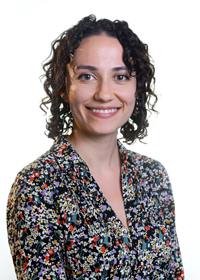
Jennifer Coulter
Harvard University
As a child, Jennifer Coulter saw herself as an artist rather than a scientist. She attended an unusual arts-focused magnet school in New Jersey that concentrated on teaching and using technology in communications fields. But she discovered she had a knack for coding when she took computer science classes. Meanwhile, physics intimidated her, but a patient teacher and mentor, Steve Godkin, answered her questions, helping her gain confidence and develop a love for that subject, too.
When Coulter started her undergraduate degree in physics at Rutgers University, the Department of Energy Computational Science Graduate Fellowship (DOE CSGF) recipient continued taking computer science classes and explored various research projects, starting with materials science. She liked the field’s practical applications but didn’t care for the experimental work. She tried high-energy nuclear physics, which depends more on computers, but gradually moved back toward materials-focused computational work.
With theoretical condensed matter physicists Premi Chandra and Karin Rabe, Coulter used density functional theory (DFT), a technique to model the electronic structure of atoms and molecules, in simulations examining properties of perovskites, compounds with potential uses in solar cells and microelectronics. That project and the accompanying mentorship helped steer Coulter’s research trajectory. “I spent a lot of time with these really experienced women, and it was so important to me.”
As a Harvard University graduate student, Coulter has continued using DFT to understand materials’ transport properties – how well they conduct heat or electricity, an important issue for device applications. Making a material and setting it up in a device to measure its properties can be expensive. “And there's no guarantee that you'll find something good,” she says.
Simulations let researchers do some of that initial work in a computer, seeking insights to tweak materials in productive ways. Experimental researchers can then focus lab work on a shorter list of materials that have the most promising properties.
The fun of this work, Coulter notes, is that she can get a result on her computer and ask lab-focused colleagues, “do you think you can tell me if I’m right?” Coulter has studied properties in two-dimensional materials – single-atom-thick layers such as graphene – and has examined piezoresistance, how bending or straining a material alters the way it conducts electricity.
Getting accurate answers to these questions takes significant time and computational resources. To streamline simulations, Coulter and her Harvard colleagues recently released high-performance computing software called Phoebe. It provides a suite of methods for predicting transport in materials using information from DFT, taking into account microscopic scattering properties of electrons and phonons (vibrations of the crystal lattice).
The package has a unique feature: It can boost efficiency on several computer architectures, including those with graphics processing units (GPUs). The team used Kokkos, a platform developed by Sandia National Laboratories researchers, allowing them to write GPU-enabled code without specifying the architecture. Although the researchers are still benchmarking Phoebe on large systems, they can get accurate results at least 100 times faster on a GPU than on a standard central processing unit.
During her 2019 practicum at Oak Ridge National Laboratory, Coulter worked with QMCPACK, a DOE-led code that uses a different strategy, quantum Monte Carlo methods, to simulate material properties. “I felt really welcome there.” She found it refreshing to work with so many computational scientists and to have lunch conversations with ORNL staff and University of Tennessee graduate students.
Coulter plans to graduate by the end of 2022. She expects to pursue postdoctoral research and possibly an academic career. The fellowship has been a tremendous asset, she says, allowing her to follow a unique research path and use an allocation of high-performance computer time at DOE’s National Energy Research Scientific Computing Center.
Coulter’s research has led her far from her first passion, drawing and digital art, but she continues to work on projects in her spare time. She also remains in contact with Godkin, her high school physics teacher, and has returned to his class to talk with students about her research and career.


